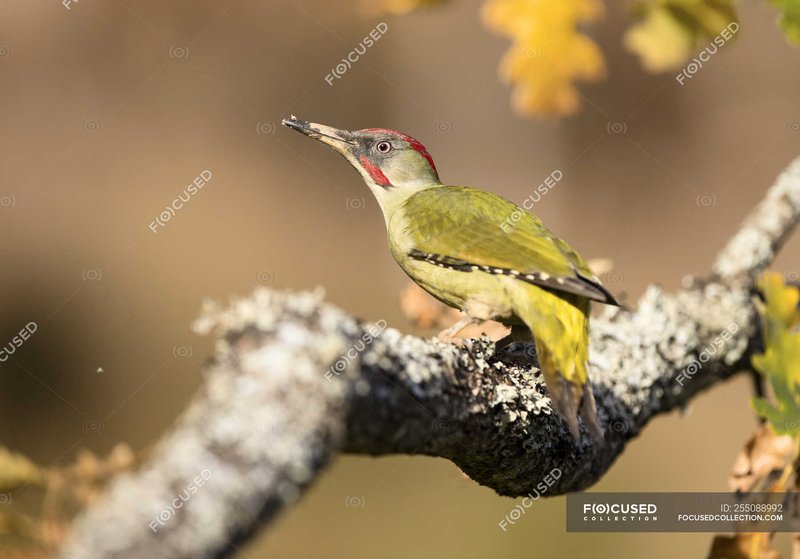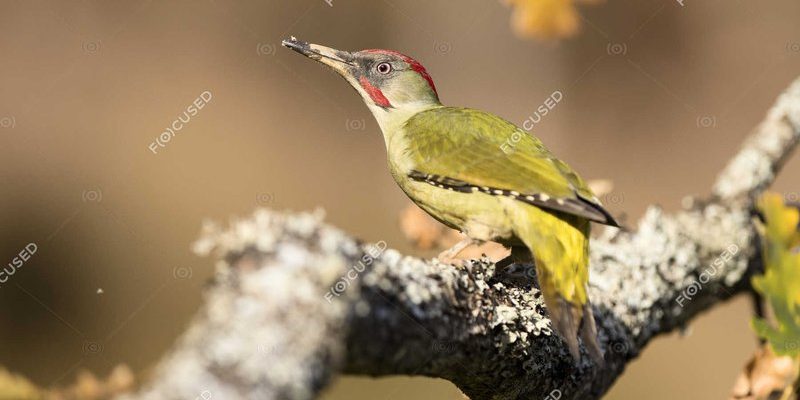
When you see a Green Woodpecker, the first thing that catches your eye is its stunning plumage. Adult Green Woodpeckers stand around 28-30 cm tall, making them a medium-sized bird. Their back and wings are primarily a bright green, which helps them camouflage among the foliage. The contrast is striking when you notice their bright yellow rump, which can almost make you do a double-take! Their faces are adorned with a red crown, providing a pop of color that stands out against the green.
But there’s more to the Green Woodpecker than just its looks. The males and females have slight differences, particularly in size and feather patterns. Males tend to have a more pronounced red patch on the back of their heads, while females display a less vibrant color. The differences are subtle, yet they are a great reminder of nature’s diversity. Their sturdy bodies are also complemented by strong legs and sharp claws that enable them to grip onto tree trunks with ease.
Another fascinating aspect is their behavior. Green Woodpeckers are known for their unique flight pattern, which includes a series of short, rapid flaps followed by a gliding phase. This style of flight can make them appear almost playful as they flit between trees. Also, they have long, sticky tongues that can extend far beyond their beaks, allowing them to extract insects from deep within the bark or the ground effortlessly.
Habitat and Range
The Green Woodpecker has a broad distribution across Europe and parts of Asia. You’ll find them in a variety of habitats, including woodlands, parks, and gardens. They prefer areas with plenty of trees, especially those that are old and decaying, as these offer ample opportunities for foraging. Their favored trees include oaks and willows, where they can easily tap into the bark for food.
Within their habitat, Green Woodpeckers are particularly fond of open spaces. This means you might spot them in parks, where they can flit between trees and enjoy a bit of sunshine. Their preference for open areas also enables them to hunt for ants—one of their primary food sources. Imagine a spacious meadow with patches of trees—that’s where you might find them happily pecking away!
As seasons change, these woodpeckers might alter their behavior slightly. During breeding season, which typically occurs in spring, they become more territorial and vocal. If you’re lucky enough to be in their territory during this time, you might hear their distinctive calls echoing through the trees. These sounds are not just for communication; they also let other woodpeckers know that a territory is claimed.
Feeding Habits
The Green Woodpecker has a diet that primarily consists of ants and beetles, making it an insectivore. While many birds chase after flying insects or seeds, the Green Woodpecker digs deep into the ground to find its meals. With its strong beak, it can peck away at the soil and bark, looking for hidden treasures. This unique foraging behavior sets them apart from other woodpecker species.
What’s particularly interesting is their preference for foraging on the ground. You might see them hopping around in grassy areas, using their keen eyesight to spot potential snacks. Their long tongues help them reach insects that are buried just beneath the surface. Think of it as a delicate treasure hunt, where they know exactly what to look for beneath the ground.
During the spring and summer months, the woodpecker’s diet is abundant, which helps in raising their young. Parents will tirelessly forage to meet the demands of their chicks, who are growing quickly and need plenty of protein. Even during the colder months, these woodpeckers can find enough food, thanks to their adaptability and keen hunting skills. So, if you’re ever in a park or garden, keep your eyes peeled—you might catch a Green Woodpecker feasting on a hidden ant or beetle!
Breeding and Nesting
When it comes to breeding, the Green Woodpecker is a dedicated parent. The mating season typically starts in the spring. During this time, males engage in impressive courtship displays to attract females, such as vocalizing and performing flight patterns that demonstrate their strength and agility. This is not just for show; it’s essential for establishing a bond and claiming territory.
Once a pair forms, they will seek out a suitable nesting site. Green Woodpeckers prefer to nest in tree cavities, often using old woodpecker holes or creating their own by pecking at softer wood. The female typically lays 4 to 6 eggs, which she incubates for about 17 days. During this time, the male helps with feeding and protecting the territory.
The chicks hatch in a vulnerable state, requiring constant care from both parents. They are fed a protein-rich diet of insects, which helps them grow rapidly. After about three weeks, the chicks fledge, meaning they leave the nest. However, they often remain in the vicinity, relying on their parents for food and protection as they learn to fly and find their own way in the world. Witnessing this nurturing process can be a beautiful experience, highlighting the dedication of these birds to their young.
Conservation Status
The conservation status of the Green Woodpecker is generally stable, with a considerable population throughout its range. However, like many wildlife species, it faces threats from habitat destruction and changes in land use. Urban development and deforestation can limit their natural habitats, making it crucial to protect the areas they rely on for feeding and nesting.
Fortunately, these woodpeckers can thrive in parks and gardens if they provide the right environment. Efforts to enhance green spaces with native trees and reduced pesticide use can offer support. You might even consider planting native plants that attract insects, creating an inviting space for these fascinating birds.
Public awareness and conservation initiatives play a significant role in protecting the Green Woodpecker and its habitat. Local conservation groups often conduct surveys and educational programs to enhance understanding of these remarkable birds and their importance in the ecosystem. By keeping our forests and parks healthy, we can help ensure that future generations can enjoy the sights and sounds of Green Woodpeckers.
Interesting Facts about the Green Woodpecker
The Green Woodpecker is full of surprises! Here’s a collection of intriguing facts that might just blow your mind:
- Green Woodpeckers have a unique call that sounds like a hysterical laugh, which is often heard echoing through woodlands.
- Unlike some other woodpecker species, Green Woodpeckers do not drill into trees exclusively; they often forage on the ground for ants.
- These woodpeckers can live up to 10 years in the wild, but many do not reach this age due to various factors like predation and environmental changes.
- Their long, sticky tongues can be up to 10 cm long, which helps them catch insects efficiently.
- In some cultures, Green Woodpeckers are considered a symbol of good luck and are associated with nature’s resilience.
FAQ
What is the typical lifespan of a Green Woodpecker?
Green Woodpeckers generally have a lifespan of around 5 to 10 years in the wild. However, factors like predation, environmental changes, and food availability can affect their life expectancy. In some cases, individuals have been known to live longer if they escape threats and find sufficient food.
Are Green Woodpeckers migratory?
Green Woodpeckers are typically not migratory birds, meaning they stay in the same region throughout the year. They do adapt their behaviors to seasonal changes, occasionally moving to find better feeding opportunities during harsher winter months. However, they usually remain within their established territories.
How do Green Woodpeckers communicate?
Communication among Green Woodpeckers includes a variety of sounds, including their distinctive laughing call, which can be heard from a distance. This vocalization is essential for establishing territory and attracting mates. Additionally, they use body language, such as drumming on trees, to communicate with others in their area.
What do Green Woodpeckers do in winter?
During winter, Green Woodpeckers continue foraging for food, primarily seeking ants and beetles hidden beneath the snow or ground. They may also rely more on trees with thick bark that provide a bit of insulation against the cold. As long as they can find food, they’ll remain active and adapt to the winter conditions.
Can I attract Green Woodpeckers to my garden?
Yes! You can attract Green Woodpeckers to your garden by creating a welcoming environment. Planting native trees, maintaining grassy areas, and avoiding pesticide use can help provide food and shelter. Additionally, creating small brush piles or leaving dead trees standing can offer ideal foraging and nesting sites.
Do Green Woodpeckers maintain their own nests?
Green Woodpeckers do maintain their own nests, typically selecting sites in trees or even utility poles. Both parents participate in digging out the nest cavity and caring for the young. They often return to the same nesting sites year after year if the conditions remain favorable.
What role do Green Woodpeckers play in the ecosystem?
Green Woodpeckers play a vital role in their ecosystems. By feeding on ants and beetles, they help control insect populations, which can be beneficial for plants and other wildlife. Additionally, their nesting habits can create habitats for other species, as abandoned woodpecker holes are often used by various birds and mammals.
Are Green Woodpeckers social birds?
Generally, Green Woodpeckers are somewhat solitary. However, they may form small groups outside of the breeding season, especially in winter when food is plentiful. During the breeding season, they become more territorial and will defend their individual spaces from others.
What is the primary threat to Green Woodpecker populations?
The greatest threats to Green Woodpecker populations include habitat loss due to urban development and deforestation. Changes in agricultural practices, particularly increased pesticide use, can also impact their food sources negatively. Conservation efforts focusing on habitat preservation are crucial for their continued survival.
Can Green Woodpeckers be found in urban areas?
Yes, Green Woodpeckers can thrive in urban areas, especially in parks and gardens that provide suitable habitats. They are adaptable birds that can find food and nesting opportunities in green spaces, which makes urban environments increasingly accommodating for these delightful woodpeckers.
How can I identify a Green Woodpecker vs. other woodpeckers?
You can identify a Green Woodpecker by its distinctive bright green plumage, red crown, and the unique laughter-like call it makes. Compared to other woodpeckers, which may have more pronounced black and white markings, the Green Woodpecker’s coloration is much more vibrant and is often a solid green. Observing their foraging behavior on the ground is another giveaway, as many woodpeckers prefer to peck at trees.

